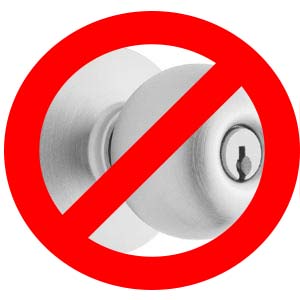Americans with Disabilities (ADA) code isn’t just wordy, it’s downright confusing – even to the veterans of the industry. First, you have the measurements, then you have all sorts of exceptions, and on top of that you have references to different sections within the code. It will undoubtedly make your head spin.
That being said, it’s no wonder that we get a lot of questions in regards to ADA code at our trade shows. Recently, the biggest question on everyone’s mind has to do with the “grasping and turning” concept in regards to door locks.
Well, allow me to confuse you. There are two current revisions of the ADA code – 2003 and 2010. While 2010 is the most recent, your jurisdiction may still be operating under 2003. That means that the 2003 code would override the 2010 code.
ADA Code Facts
The 2003 ADA code states:
ANSI 117.1-2003; 404.2.6
“Handles, pulls, latches, locks, and other operable parts on accessible doors shall have a shape that is easy to grasp with one hand and does not require tight grasping, pinching, or twisting of the wrist to operate…”
The 2010 code states:
ANSI 117.1-2010; 404.2.7
“…Advisory 404.2.7 Door and Gate Hardware: Door hardware that can be operated with a closed fist or loose grip accommodates the greatest range of users. Hardware that requires simultaneous hand and finger movements require greater dexterity and coordination, and is not recommended.”
Breaking it Down
While it may not seem like it, this is a huge difference. The 2003 ADA code essentially bans any lock that you couldn’t operate with a closed fist (such as a knob or non-compliant deadbolt); whereas, the 2010 code strongly dissuades it but does not prohibit it.
What does this mean for you? First off, you need to find out what code your jurisdiction is currently operating under. You can do so by contacting your local AHJ.
If you are under the 2003 code, the use of keypad locks, knob sets, and non-compliant deadbolts on accessible doors is prohibited. To be fully code compliant, stick with regular lever sets and exit bars.
If you are under the 2010 code, you have a bit more leeway. We recommend using lever sets, but should you need to use keypad locks you will still be code compliant. While knob sets are still within the gray area of the 2010 code, we do not recommend using them.
Have you run into ADA issues with your locks? What problems have you had? We’d be happy to weigh in and answer your questions!


I always find myself debating with architects on installing hardware in public housing entrance unit doors that copy with ADA. I’m in Puerto Rico and as a standard entrance doors always have a lock and a dedbolt. the lock is always a lever lock but then we have the thumb turn issue on deadbolts!
Security versus ADA compliance? ADA compliance only? Does 2010 ADA version gives me the flexibility to the fact that deadbolts can be installed on these doors?
Any thoughts on this!!
Hi Rochi-
There are actually ADA compliant deadbolts. They have a longer thumb turn. Falcon has a few different options; here is one. These must be installed within the accessible height between 34″-48″ above the finished floor.
Thank you for your question! I have updated the post to add a bit more clarity on the issue.
I hope this helps!
-Katie
Katie; huge thanks for your reply. I was wondering if you could refer me to the ADA section where it states the requirements a dead bolt needs to have in order to comply with ADA. ? Or is it only a longer thumb turn? Maybe how long does it have to be? Thanks again.
Hi Rochi-
I apologize for the delayed response. The section that addresses this is 404.2.7. I don’t believe it specifically calls out exact requirements, which is what can make ADA so frustrating. When you specify a deadbolt, the manufacturer’s deadbolt specifications should note if it is ADA compliant. I hope that helps. Let me know if you have any further questions!
-Katie
We are opening a yoga studio and would like to use a residential entry door for decorative reasons. We would also like to use a keypad to allow teachers to have a code to enter without a key. We need something that allows the door to be unlocked during business hours (ie no automatic or adjustable automatic lock), and ADA compliant. Would appreciate your input. Thanks k you,
Kevin
I need to avoid automatic locking so it does not lock out the public during hours we are open. . . I am looking for something that IS adjustable and can be kept unlocked during business hours.
Hi, Kevin! If you want to contact Dave Path at davidp@locknet.com, he’ll be able to give you specifics on what you can do.